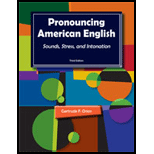Pronouncing American English Third Edition Pdf
- Pronouncing American English Third Edition Pdf Free
- Pronouncing American English Third Edition Pdf Download
Pronouncing American English Audio CDs (10) Gertrude F. Orion on Amazon.com.FREE. shipping on qualifying offers. Ideal for a complete course or as a pronunciation supplement, PRONOUNCING AMERICAN ENGLISH provides extensive activities to help college-bound students develop clear speech and appropriate intonation. Cambridge English Pronouncing Dictionary English Pronouncing Dictionary Cambridge Dictionary Cambridge Third Edition Dictionary Cambridge Dictionary Family Word Cambridge Advanced Learner's Dictionary Cambridge Dictionary Third Edition Free Download English To English Dictionary Free Pdf English Dictionary English Dictionary Pdf Dhivehi To.

A Pronouncing Dictionary of American English, also referred to as Kenyon and Knott, was first published by the G. & C. Merriam Company in 1944, and written by John Samuel Kenyon and Thomas A. Knott. It provides a phonemic transcription of General American pronunciations of words, using symbols largely corresponding to those of the IPA. A similar work for English pronunciation is the English Pronouncing Dictionary by Daniel Jones, originally published in 1917 and available in revised editions ever since.[1]
Edward Artin, who succeeded Kenyon as the pronunciation editor of Webster's Dictionary, sought to revise the pronouncing dictionary many years after the publication of Webster's Third (1961), but to no avail, since none of the publishers Artin approached, including the Merriam company, thought it profitable to publish a new edition of the dictionary.[2] After 40 years since its publication, the pronouncing dictionary was still considered the 'only major pronouncing dictionary of this century to appear in the United States' according to linguistics historian Arthur J. Bronstein.[3]
Many of the pronunciations in the dictionary seem antiquated today and dictionaries such as Longman Pronunciation Dictionary, edited by John C. Wells, have replaced it, providing more contemporary pronunciations.
Transcription[edit]
The dictionary uses a broad transcription rather than a narrow one. For example, the long o vowel of 'toe', which is a diphthong in open syllables in most American accents, is represented by the single symbol ⟨o⟩, rather than ⟨oʊ⟩ as it would be represented in a narrow transcription.
Pronouncing American English Third Edition Pdf Free
Deviations from the IPA found in the dictionary are mostly made for typographical convenience: Dd form 626 requires drivers to provide.
- The symbol ⟨ᴜ⟩ (a small capital U) is used instead of ⟨ʊ⟩ for the vowel of foot and the second part of the diphthong of mouth.
- The 'looptail g' is used instead of the 'opentail g' of the IPA.
- The symbol ⟨[r]⟩ is used instead of [ɹ]/[ɻ] to denote the postalveolar/retroflex approximant of American English.
- The markers for primary and secondary stress tilt slightly toward the center rather than being absolutely vertical. In other words, they look more like and / than like and .
- The colon ⟨:⟩ is used in place of IPA ⟨ː⟩ to indicate length, although length is rarely marked in the dictionary.
- In foreign words, a barred g (ǥ) is used instead of ⟨ɣ⟩ to indicate a voiced velar fricative.
One principal application of Kenyon and Knott's system is to teach American English pronunciation to non-native speakers of English. It is commonly used for this purpose in Taiwan, where it is commonly known as 'KK Phonetic Transcription' in Chinese.

References[edit]
- ^Cambridge English Pronouncing Dictionary, Daniel Jones. 18th ed (current as of 2012)
- ^Morton, Herbert C. (1995). The Story of Webster's Third: Philip Gove's Controversial Dictionary and Its Critics. Cambridge University Press. ISBN0-52155869-7. Pages 125–6.
- ^Bronstein, Arthur J. (1986). 'The History of Pronunciation in English-Language Dictionaries'. In Hartmann, Reinhard (ed.). The History of Lexicography. pp. 23–33. doi:10.1075/sihols.40.04bro. ISBN90-2724523-1. Page 27.
Pronouncing American English Third Edition Pdf Download
- Kenyon, John S.; Thomas A. Knott (1953). A Pronouncing Dictionary of American English (2nd ed.). Springfield, Mass.: Merriam-Webster. ISBN0-87779-047-7.





